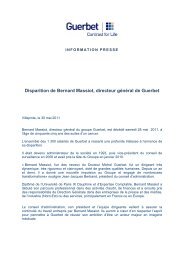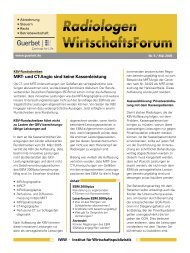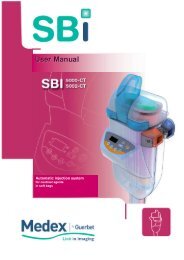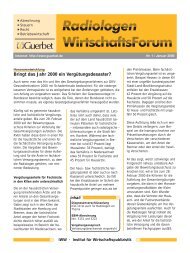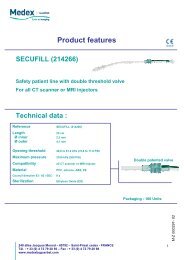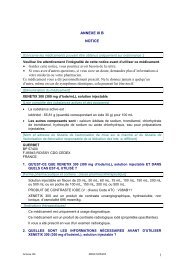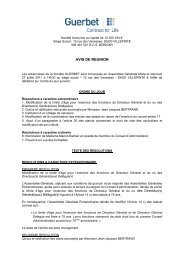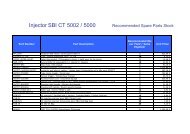Read the Registration Document - Guerbet
Read the Registration Document - Guerbet
Read the Registration Document - Guerbet
You also want an ePaper? Increase the reach of your titles
YUMPU automatically turns print PDFs into web optimized ePapers that Google loves.
c) Property, plant and equipmentProperty, plant and equipment are recorded at acquisition cost. Depreciation is calculated on a straight-linebasis over <strong>the</strong> estimated useful life of <strong>the</strong>se assets:- Buildings: 20 years;- Fixtures, fittings: 10 years;- Machinery and equipment: 5 to 10 years;- O<strong>the</strong>r tangible assets: 5 to 10 years.For all acquisitions until 31 December 1997, and again starting on 1 January 2002, all possibilities offeredby tax regulations concerning accelerated and exceptional depreciation have been used. The varianceresulting from <strong>the</strong> difference between accelerated and straight-line depreciation is considered as a specialaccelerated tax depreciation.Property, plant and equipment may be written down to reflect <strong>the</strong>ir utilisation by <strong>Guerbet</strong>.d) Investments and non-current assetsInvestments are recorded at cost and depreciated to reflect <strong>the</strong> share of net equity of subsidiaries after <strong>the</strong>restatement of <strong>the</strong>ir intangible assets.O<strong>the</strong>r non-current assets are recorded at <strong>the</strong> lower of <strong>the</strong>ir cost or <strong>the</strong>ir carrying value.e) Inventories and production in progressRaw materials and o<strong>the</strong>r supplies are recorded at <strong>the</strong> opening weighted average price. When <strong>the</strong> carryingvalue falls below this amount, a provision is recorded for <strong>the</strong> difference. Provisions are also made forinventories subject to low turnover rates.Production in progress and finished goods are recorded on <strong>the</strong> basis of production cost which includesdirect and indirect production costs and excludes headquarters, financial or selling expenses. A provisionfor impairment is made when justified by <strong>the</strong> inventory turnover rate and when <strong>the</strong>re is a risk that productswill not be sold before <strong>the</strong>ir expiration dates are reached or sold at a loss.f) Trade receivables and related accountsAccounts receivable are recorded at face value.An allowance for doubtful accounts is recorded when a collection risk exists which is determined on a caseby-casebasis.The company has recourse to <strong>the</strong> securitisation of receivables. This transaction consists of <strong>the</strong> assignmentof <strong>the</strong> trade receivables by <strong>the</strong> company owed by customers to an entity (specifically created for thispurpose) that finances <strong>the</strong> acquisition of <strong>the</strong> receivables by <strong>the</strong> issuance of securities on capital markets.From an accounting perspective, securitisation corresponds to <strong>the</strong> assignment of receivables whereby:- Receivables assigned are eliminated from <strong>the</strong> balance sheet of <strong>the</strong> assignor;- All costs incurred on <strong>the</strong> transaction are expensed in <strong>the</strong> corresponding period.g) Marketable securitiesMarketable securities are recorded at cost. When <strong>the</strong> carrying value of <strong>the</strong> securities, determined on <strong>the</strong>basis of <strong>the</strong>ir estimated market value, i.e. <strong>the</strong>ir net asset value on <strong>the</strong> closing date, is less than <strong>the</strong>acquisition cost, a provision for impairment is recorded.h) Financial instrumentsWhen interest rate options are acquired, premium is posted to <strong>the</strong> income statement pro rata over <strong>the</strong>duration of <strong>the</strong> contract. Provisions are made for eventual charges resulting from interest rate fluctuations.To manage foreign exchange and interest rate exposure from its industrial and commercial activities, <strong>the</strong>Group has recourse to derivatives traded in organised markets. Group policy prohibits trading in suchmarkets on a speculative basis.119




